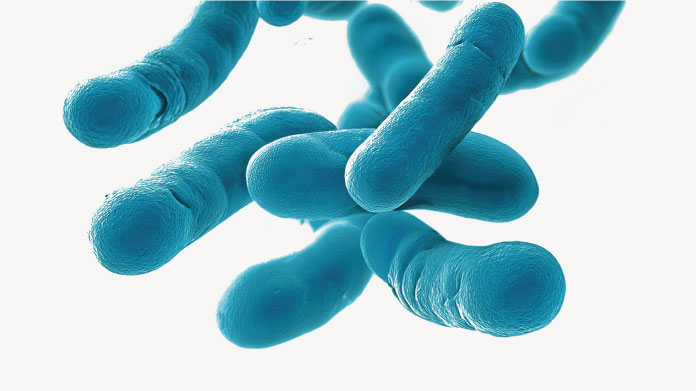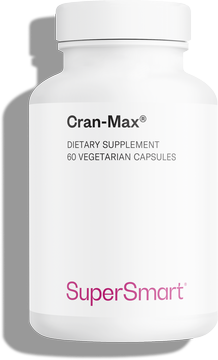Should Probiotics be Kept in the Fridge?
Do probiotics need to be kept in the fridge in order to survive? And if so, does sending these same probiotics through the post mean they might be lost en route?

It’s a legitimate question. Given that the microorganisms that flourish in the gut develop in a hostile environment, at a temperature close to 38°C, it’s hard to see why they need to be kept refrigerated. To clarify the issue, let’s take a step back, to the point at which probiotics are manufactured.
General effects of probiotics on the microbial community
You’ve no doubt heard it said that a probiotic should provide at least 1 billion viable microorganisms per capsule (this is referred to as ‘CFU’ for ‘colony-forming units’). One billion might seem an astronomical number but it’s nothing in comparison to the 100,000 billion organisms that populate our gastrointestinal tract. These organisms form a highly-complex microbial community (1-2) which is in constant communication with the body and all of its constituent parts (3). Some live in the colon, others prefer more oxygenated areas such as the duodenum or ileum, while the more indestructible types favor the stomach. Each has its own preferences. The gastrointestinal tract undoubtedly offers an amazing variety of habitats for bacteria seeking heat, moisture, and food.
With its fertile environment and strategic location, the digestive tract is able to host ecosystems that are highly stable: the composition of a healthy individual’s gut flora does not fundamentally change over time. But occasional or prolonged variations can sometimes occur and disrupt the balance. Every day, around 10 billion bacteria and yeasts from the diet are parachuted into the stomach. Those that survive this ‘baptism by fire’ are quickly wiped out – provided, that is, that the established microbial communities populating the gut are robust and flourishing. But if they’ve been left weakened by a recent short-term or chronic imbalance, any surviving pathogens seize on this opportunity to ‘take up residence’ in an unoccupied area … It’s then that intestinal problems can arise, and then that probiotics are most effective.
A probiotic is not designed for long-term colonization of the intestinal mucosa. Some strains will be able to last a few hours there, others a few weeks (it all depends on the strain’s persistence), but in general, a probiotic’s effects will cease soon after supplementation ends. However, this period of activity is usually long enough for it to exert significant benefits. Some probiotics will secrete certain substances (hydrogen peroxide, bacteriocins), while others will reduce the environment’s acidity. Some will even interact with host cells to induce mucus secretion or increase production of certain immunoglobulins (5). There are normally four major beneficial effects:
- Improved digestive function;
- Stronger intestinal barrier function;
- A more effective immune system.
Do probiotics really need to be ‘live’ in order to provide benefits?
For the most part, yes. Scientific research shows that probiotic microorganisms do indeed need to be 'living' to exert these effects.
For the most part, but not exclusively, as in certain cases, taking non-live probiotics will also generate beneficial effects. For example, when you take non-live L. rhamnosus type probiotics, you’re ingesting all the bacteria’s cellular components. It’s impossible for it to secrete new substances or reproduce in your digestive tract, but some of its constituents are still able to act! The lactase it contains plays a part in hydrolyzing lactose (6) and thus helps you digest milk better, so reducing digestive discomfort. The bacteria’s DNA, a highly-resistant structure, can also influence cell signaling pathways. The strain Lactobacillus reuteri contained in SuperSmart's H. Pylori Formula supplement, tends to reduce H. pylori's impact. It doesn’t need to be live in order to do this.
Nonetheless, the beneficial effects of bacteria are usually dependent on them being alive, and more precisely, alive at the point of entry into the intestinal tract. This means they have to survive stomach-emptying movements, acid secretion, other enzymes, contact with bile, etc. (7) as well as the original manufacturing process, encapsulation, and storage.
The quality of probiotic dehydration significantly affects their viability
The fact that probiotics need to be living when they reach the gut presents laboratories with a major challenge. After the strains have been selected and fermented, the probiotics are in perfect condition, but how can they be kept that way until they reach the consumer? How can they be dispatched all over the world without getting lost? Simply putting them in a bottle, away from their natural environment and deprived of food, is hardly going to keep them alive for very long. Realistically, there’s only one solution: they have to be dehydrated. Water prevents long-term stabilisation of cells – it’s water that maintains the biochemical reactions essential for life (8). Without it, time stops. So when bacteria are dehydrated, they are temporarily deprived of life – the interruption to their supply of oxygen and sugars means they are ‘inactivated’ until the point at which they are rehydrated.
Dehydration is thus a great idea but given that water accounts for 70% of a cell’s volume, it requires very careful implementation. Two main techniques are used: atomisation and lyophilisation (or freeze-drying). In the first, and less expensive, of these two options, the probiotic cells are simply passed through a flow of very hot air, and essentially, the dehydration is complete. However, it’s the less attractive option as the hot air significantly degrades the probiotic’s membranes, proteins, and DNA (9), so much so that when they’re rehydrated, there’s virtually no chance they’ll function normally. The second option is more expensive but is much better at preserving cells (10). With freeze-drying, the probiotics are dehydrated at a low temperature and pressure. The water is first frozen, then sublimated (passed directly from the solid to the gas phase), enabling almost all the water to be eliminated without exposing the cells to damaging temperatures. Remember that the aim is not simply to dehydrate the probiotics but to ensure they’re able to function normally once they’re rehydrated. And this depends hugely on the type of dehydration technique used by the manufacturer, but it also depends on how well they’re stored!
The risks posed by oxygen during storage
Once the probiotic cells are dehydrated, they can be deprived of food and placed in unfavorable conditions – though not too unfavorable - without fear of them getting lost. When water is removed from cells, cell components come into direct contact with ambient air, and importantly, with oxygen. The risk of ‘oxidative stress’ is therefore at its greatest. Not only are dehydrated probiotic cells more exposed to reactive oxygen species, but they’re also deprived of the antioxidant tools they need to combat them. These free radicals – the same molecules that play a key role in the aging process – break down the cells’ membranes, intracellular proteins, and DNA (11) to such an extent as to make them unviable once they’re rehydrated.
Thus the first precaution to take to ensure probiotics remain viable is to package them in a hermetically-sealed container to reduce any contact with the atmosphere. For certain highly-fragile strains, individual blister-packing of capsules prevents them from being exposed to air each time the pot is opened. Exposure to oxygen can also be minimized by using a special encapsulation technique called microspherization, in which the probiotics are coated in microparticles which form a physical barrier against the environment (12).
There are other ways manufacturers can reduce the risk of oxidative stress during storage. It’s common practice, for example, to add ingredients such as prebiotics (SuperSmart uses inulin, for instance) to replace the molecules of water and help maintain cell structures. Without water, structures such as cell membranes become somewhat unstable and components have a tendency to move around.
It’s also possible to ‘stress’ the cells before freeze-drying them, to stimulate an increase in their antioxidant defense mechanisms. Stressing them makes them over-express certain genes involved in fighting this type of stress, making them more resistant during storage.
Why is the temperature at which they’re stored so important?
Exposure to air is an important factor in a probiotic’s viability, but so too is the temperature at which it’s stored. Although probiotic cells like the heat while they’re developing, the opposite is true once they’re dehydrated.
There’s a simple explanation for this: the higher the temperature, the greater the level of random movement of the molecules. This is called thermal agitation. A temperature of 40°C is ideal for a probiotic in its development stage because it encourages molecules to move around and thus supports the biochemical reactions that enable life. But in the case of dehydrated probiotics, there are no biochemical reactions! On the contrary, the movement of molecules, particularly in cells that make up the plasma membrane, increases the risk of disorganization and rupture of the bonds between cellular components, already weakened by the absence of water.
Thus the second measure to maintain a probiotic’s viability is to store it at a low temperature. This isn’t necessarily the case for all probiotics: the specific cellular composition of yeasts and bacterial spores (such as Bacillus subtitilis) means they’re able to withstand very high temperatures and do not need to be refrigerated. But generally-speaking, the higher the temperature during storage, the higher the risk of non-viability. The risk also increases the longer the probiotics are stored at the wrong temperature. In other words, if you forget to put your probiotics in the fridge for one night, there’s no need to panic. One night at room temperature will not cause sufficient degradation to make them unviable. The worst that will happen is that a tiny percentage of the probiotics will be lost.
Similarly, sending probiotics by post will not harm their viability. This is particularly so for probiotics encapsulated using delayed release capsules (the previously-mentioned microparticle technique), those that have been freeze-dried rather than atomized, and those that contain protective compounds such as inulin (a type of non-digestible fiber naturally extracted from chicory root) (13). For high-quality probiotics like these, studies have shown that storing them at room temperature (no higher than 21°C), and at low humidity (we’ll come back to this), did not lead to a significant reduction in viability after 10 months (14). It’s completely different, however, if these same probiotics are stored for the same period at a temperature of 37°C – almost all their viability will be lost.
It’s therefore important to ensure that your probiotics provider has stored them in a cold, dry place. If you’re buying a probiotics supplement in the middle of summer, make sure you’re home when it’s delivered to minimize the risk of degradation. Freeze-dried probiotics, in delayed release capsules, will maintain their viability when exposed to unsuitable temperatures for a short time, say during a heatwave, but not for long. Take care to always put them back in the fridge after use: they have been compromised and it’s important not to risk their viability.
With respect to air transport, however, there’s no need to worry: freeze-dried probiotics are in no way damaged by the extremely cold temperatures in cargo holds. In fact, such temperatures are much better for preserving the probiotics than room temperature.
Why is humidity important?
The third factor influencing a probiotic’s viability is humidity (or the activity of water, to be precise).
You’ve seen how the amount of water in a probiotic cell is key to its preservation. The reason the water in these cells is removed is precisely to enable them to be preserved for months at a time. Now, when an element with very little water comes into contact with moisture-rich air, natural exchanges take place to rebalance the water content of the two elements. In other words, the low-water element tends to absorb any surplus water in the air until both elements have the same water content. Your dehydrated probiotic – containing very little water – is therefore likely to absorb the water from the atmosphere in which it’s placed. The more damp the atmosphere, the more this will happen, and the more water the probiotic absorbs, the more fragile it becomes. A number of studies have shown that humidity significantly accelerates damage to probiotics (15-16), causing browning reactions and the appearance of Maillard reaction products. Such damage drastically reduces the probiotics’ viability.
This third factor poses a real conundrum because the fridge is a damper environment than ambient air. It’s therefore important to choose probiotics that come in very low moisture capsules (4-6% in the case of delayed release capsules as opposed to 10-16% for standard capsules), and packaged in a sealed container or in individual blister-packs. If you want to take maximum precautions, you should place your probiotics on the highest shelf in the fridge where it’s drier.
Is stomach acidity a major challenge for probiotics?
There’s a fourth factor influencing the viability of probiotics and it is the way the contents of the capsule are released.
A standard capsule will dissolve in the stomach as a result of the milieu’s acidity. So when delivered in such capsules, billions of dehydrated probiotics are released into this unfavorable environment. They are immediately rehydrated and are thus no longer dormant, but have to then withstand the acidity of the stomach in order to reach the gentler environment of the gut alive and intact, where they will be reunited with all the conditions conducive to their growth. In theory, the majority of probiotic species of the Lactobacillus, Bifidobacterium, and Streptococcus genera are able to transition safely through the stomach – especially if supplements are taken in the morning on an empty stomach and if the storage conditions are right – but in practice, a considerable number will fail to ‘stay the course’.
To prevent a significant percentage of the probiotics ‘falling at the final hurdle’, manufacturers use gastro-resistant or delayed-release capsules. These capsules only disintegrate once they’ve passed through the stomach (50-70 minutes after ingestion for delayed release capsules, 45 minutes for standard capsules). This minimizes the amount of contact time between the probiotics and the acid elements of the stomach.
If you’ve been paying close attention, you’ll have realized that the number of CFU listed on the label of a probiotic supplement is not actually that important. It’s not the overall number of microorganisms that counts, but the amount that arrives in the gut, live and intact. And this depends on the manufacturer, the method of transport, and the consumer. In brief then, here’s a summary of factors that help maximise the viability of probiotics (17):
- Using a freeze-drying rather than atomization technique in the manufacturing process.
- Adding protective compounds (particularly non-digestible forms of fiber) during the dehydration stage to support water-deprived cellular structures.
- Storing the supplement in a refrigerated, dry place throughout the period between manufacture and dispatch.
- Using specific capsules that minimize oxidative stress and contact with moisture.
- Using delayed-release or gastro-resistant capsules to prevent potential last-minute damage.
- Ensuring an adequate initial level of microorganisms in a capsule (even though this number can quickly fall if other optimal viability conditions are not met).
- Packaging the capsules in a sealed container or in individual blister packs or sticks.
- Exposing the probiotics to extreme temperatures (above 37-40°C) for as short a time as possible during the dispatch and delivery stages.
- Storing the probiotics on a high shelf in the fridge.
The following supplements should ideally be kept in the fridge:
- Probio Forte, one of SuperSmart’s benchmark product (delayed-release capsules, low moisture, added inulin, blister-packed, freeze-dried, refrigerated before dispatch).
- Candalb (delayed-release capsules, low moisture, added inulin, sealed pot, freeze-dried, refrigerated before dispatch).
- Oral Health (individual sticks, added sorbitol, freeze-dried, sealed packaging, refrigerated before dispatch).
- Vaginal Health (delayed-release capsules, low moisture, added inulin, sealed pot, freeze-dried, refrigerated before dispatch).
- Bifidobacterium Longum (delayed-release capsules, low moisture, added inulin, sealed pot, freeze-dried, refrigerated before dispatch).
- Lactobacillus Gasseri (delayed-release capsules, low moisture, added inulin, sealed pot, freeze-dried, refrigerated before dispatch).
- Lactobacillus Reuteri (delayed-release capsules, low moisture, added inulin, sealed pot, freeze-dried, refrigerated before dispatch).
- Lactobacillus Rhamnosus (delayed-release capsules, low moisture, added inulin, sealed pot, freeze-dried, refrigerated before dispatch).
- Lactoxira (delayed-release capsules, low moisture, added inulin, sealed pot, freeze-dried, refrigerated before dispatch).
The following products can be stored at room temperature (no higher than 21°C):
- Bacillus Subtilis in delayed release capsules (bacterial-spore type probiotics are very resistant to higher temperatures).
- H. Pylori Formula (the probiotics in this supplement are active even though they’re non-live).
- Saccharomyces Boulardii (yeast-type probiotics remain stable at room temperature).
If you have any other questions about probiotics, don’t hesitate to contact us! You’ll also find more information in this article on how long should a course of probiotics last.
Keywords
1 Days
Great customer service - responsive …
I ordered from them and my item was unavailable for sometime. I was super happy when they reactivated my order and shipped my item which arrived very quickly. Great customer service.
Ruth Rueter
2 Days
Super fast shipping
Super fast shipping
Donald Borling
5 Days
Reputable companysearch and the number of…
The research and the number of selection of products.
NAKHJAVAN Shervin
18 Days
The Anti Aromatase is a great product
The Anti Aromatase is a great product. You just need to have constant inventory. Recently this product has been out of stock.
GEORGE Verne
20 Days
Great help on chat
Great help on chat. Knowledgeable and friendly.
Jason Argos
23 Days
Customer service was fast and friendly.
Customer service helped to stop the transaction process of the subscription. I appreciated that.
Greenie
24 Days
I order here due to the high quality of…
I order here due to the high quality of the products and the quick delivery of items - thank you
Barbara J
25 Days
SuperSmart's Eye Pressure supplements: highly recommended!
I purchase SuperSmart's Eye Pressure supplements regularly for over 5 years, and gotta say they are truly a wonderful product for my Glaucoma. Highly recommended if you have eye pain from your Glaucoma.
D. Martinez
30 Days
Quick service
Quick service
MONELL
30 Days
Speedy service.
Speedy service.
ROSENTHAL Marvin
34 Days
Clear website- Efficient
Clear website. Excellent search engine and fast delivery!
Mohamad Hussein
37 Days
They have great products.
They have great products.
Vickie
37 Days
Great Shipping Time!
You Have A Great Shipping Time! Praise The Lord!
DMHoge
39 Days
Doctor Recommended!
Good pricing, very good availability, doctor recommended (couldn't find what I needed anywhere else), and it took only a week to arrive (which I can't complain about).
Al
39 Days
Great product and fast shipping
Great product and fast shipping
Marie





